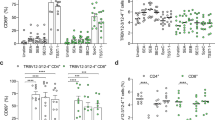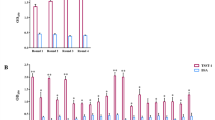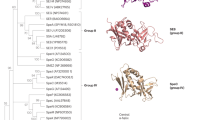Abstract
The aim of this study was to examine the production of superantigenic toxins in vivo and in vitro in two patients with streptococcal toxic shock syndrome (TSS). In the first patient, a woman with puerperal fever and Streptococcus pyogenes peritonitis, flow cytometry of blood cells and in vitro studies of the isolate showed massive expansion of Vbeta 2-positive T cells corresponding to SpeC production. In the second case, involving a patient with streptococcal TSS and purpura fulminans following non-steroidal anti-inflammatory drug (NSAID) therapy, no Vbeta expansion of T cells was observed in vivo, but the SpeC Vbeta signature was also detected in vitro. In this latter patient, NSAID administration and/or severe disseminated infection might partly explain the absence of Vbeta T cell expansion in vivo. Combined in vivo and in vitro detection of a superantigenic toxin Vbeta signature may be useful to determine which superantigenic toxin is involved in individual cases of streptococcal TSS.

Similar content being viewed by others
References
McCormick JK, Yarwood JM, Schlievert PM (2001) Toxic shock syndrome and bacterial superantigens: an update. Annu Rev Microbiol 55:77–104. doi:10.1146/annurev.micro.55.1.77
Cunningham MW (2000) Pathogenesis of group A streptococcal infections. Clin Microbiol Rev 13:470–511. doi:10.1128/CMR.13.3.470-511.2000
Yu CE, Ferretti JJ (1991) Frequency of the erythrogenic toxin B and C genes (speB and speC) among clinical isolates of group A streptococci. Infect Immun 59:211–215
Darenberg J, Luca-Harari B, Jasir A et al (2007) Molecular and clinical characteristics of invasive group A streptococcal infection in Sweden. Clin Infect Dis 45:450–458. doi:10.1086/519936
Li PL, Tiedemann RE, Moffat SL, Fraser JD (1997) The superantigen streptococcal pyrogenic exotoxin C (SPE-C) exhibits a novel mode of action. J Exp Med 186:375–383. doi:10.1084/jem.186.3.375
Michie C, Scott A, Cheesbrough J, Beverley P, Pasvol G (1994) Streptococcal toxic shock-like syndrome: evidence of superantigen activity and its effects on T lymphocyte subsets in vivo. Clin Exp Immunol 98:140–144
Watanabe-Ohnishi R, Low DE, McGeer A et al (1995) Selective depletion of V beta-bearing T cells in patients with severe invasive group A streptococcal infections and streptococcal toxic shock syndrome. Ontario Streptococcal Study Project. J Infect Dis 171:74–84
Choi YW, Kotzin B, Herron L, Callahan J, Marrack P, Kappler J (1989) Interaction of Staphylococcus aureus toxin “superantigens” with human T cells. Proc Natl Acad Sci USA 86:8941–8945. doi:10.1073/pnas.86.22.8941
Matsuda Y, Kato H, Yamada R et al (2003) Early and definitive diagnosis of toxic shock syndrome by detection of marked expansion of T-cell-receptor VBeta2-positive T cells. Emerg Infect Dis 9:387–389
MacIsaac C, Curtis N, Cade J, Visvanathan K (2003) Rapid analysis of the Vbeta repertoire of CD4 and CD8 T lymphocytes in whole blood. J Immunol Methods 283:9–15. doi:10.1016/S0022-1759(03)00260-6
Chatellier S, Ihendyane N, Kansal RG et al (2000) Genetic relatedness and superantigen expression in group A Streptococcus serotype M1 isolates from patients with severe and nonsevere invasive diseases. Infect Immun 68:3523–3534. doi:10.1128/IAI.68.6.3523-3534.2000
Tyler SD, Johnson WM, Huang JC et al (1992) Streptococcal erythrogenic toxin genes: detection by polymerase chain reaction and association with disease in strains isolated in Canada from 1940 to 1991. J Clin Microbiol 30:3127–3131
Abe J, Forrester J, Nakahara T, Lafferty A, Kotzin BL, Leung DY (1991) Selective stimulation of human T cells with streptococcal erythrogenic toxins A and B. J Immunol 46:3747–3750
Mollick JA, Miller GG, Musser JM, Cook RG, Grossman D, Rich RR (1993) A novel superantigen isolated from pathogenic strains of Streptococcus pyogenes with aminoterminal homology to staphylococcal enterotoxins B and C. J Clin Invest 92:710–719. doi:10.1172/JCI116641
Chiang-Ni C, Wu JJ (2008) Effects of streptococcal pyrogenic exotoxin B on pathogenesis of Streptococcus pyogenes. J Formos Med Assoc 107:677–685. doi:10.1016/S0929-6646(08)60112-6
Enright MC, Spratt BG, Kalia A, Cross JH, Bessen DE (2001) Multilocus sequence typing of Streptococcus pyogenes and the relationships between emm type and clone. Infect Immun 69:2416–2427. doi:10.1128/IAI.69.4.2416-2427.2001
Graham MR, Virtaneva K, Porcella SF et al (2006) Analysis of the transcriptome of group A Streptococcus in mouse soft tissue infection. Am J Pathol 169:927–942. doi:10.2353/ajpath.2006.060112
Norrby-Teglund A, Muller MP, Mcgeer A et al (2005) Successful management of severe group A streptococcal soft tissue infections using an aggressive medical regimen including intravenous polyspecific immunoglobulin together with a conservative surgical approach. Scand J Infect Dis 37:166–172. doi:10.1080/00365540500372960
Hotchkiss RS, Karl IE (2003) The pathophysiology and treatment of sepsis. N Engl J Med 348:138–150. doi:10.1056/NEJMra021333
Middelveld RJ, Alving K (2000) Synergistic septicemic action of the gram-positive bacterial cell wall components peptidoglycan and lipoteichoic acid in the pig in vivo. Shock 3:297–306
Rossi Paccani S, Boncristiano M, Baldari CT (2003) Molecular mechanisms underlying suppression of lymphocyte responses by nonsteroidal antiinflammatory drugs. Cell Mol Life Sci 60:1071–1083
Commons R, Rogers S, Gooding T et al (2008) Superantigen genes in group A streptococcal isolates and their relationship with emm types. J Med Microbiol 57:1238–1246. doi:10.1099/jmm.0.2008/001156-0
Proft T, Arcus VL, Handley V, Baker EN, Fraser D (2001) Immunological and biochemical characterization of streptococcal pyrogenic exotoxins I and J (SPE-I and SOE-J) from Streptococcus pyogenes. J Immunol 166:6711–6719
Acknowledgments
We thank Cédric Badiou for his technical assistance and David Young for his editorial guidance.
Author information
Authors and Affiliations
Corresponding author
Rights and permissions
About this article
Cite this article
Thomas, D., Perpoint, T., Dauwalder, O. et al. In vivo and in vitro detection of a superantigenic toxin Vbeta signature in two forms of streptococcal toxic shock syndrome. Eur J Clin Microbiol Infect Dis 28, 671–676 (2009). https://doi.org/10.1007/s10096-008-0671-7
Received:
Accepted:
Published:
Issue Date:
DOI: https://doi.org/10.1007/s10096-008-0671-7




